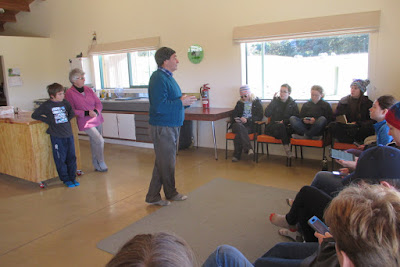Once there, Trevor gave us a brief overview of how they came to be a part of the green dot program and what kind of work they do on the farm. After hearing about the subsidies being offered by the Selwyn District Council for people to plant or regenerate native bush, they had an ecological survey done on their land to identify the native species growing there. A surprising 50 species of native bush were identified, so they applied for the funding and were granted money to install fencing, buy more plants, and provide labor for the plantings. The first block was planted about six years ago and they've been able to create two more blocks through money saved by installing their own fencing, getting a local Lions club to help plant the plants, and increasing the space between plants in each block (to spread them out). The plants they buy are from the Department of Conservation nursery because they use locally sourced seeds instead of seed imported from other parts of the country. Trevor estimated 6,000 plants have been planted on the 61 hectare property—an impressive figure, I'd say. The farm is primarily used for raising sheep for wool and meat production, however Trevor and Heather also give farm tours throughout the week.
After their talk, we got into our first task of the day—trailblazing. We tramped through the first block with loppers and chainsaws a blazin', clearing out any overgrowth on the trails. Then, some of us were tasked with removing leftover CombiGuards from the plants in one of the blocks. We took a short walk through part of the property to identify some plants (such as black beech, silver beech, red beech, and golden akeake) before taking a lunch break.
Our next task was planting 50 silver tussocks in another block on the property. Through some efficient displays of teamwork, we quickly got that job done and went back to the paddocks to watch Trevor gave a sheep herding demonstration with his dog Jack. The real treat came when we gathered in the main building to hear more about wool. Trevor explained a bit about the type of sheep he raises (Romney Texel) and what the wool is used for (carpets, mainly) and then he pulled out a live sheep for an up close and personal shearing experience.
We took a quick walk to the Waimakariri river to try out our stone skipping skills before saying our goodbyes to Trevor and company. Not far down the road, we stopped at Lords Bush to have a taste of honeydew, a secretion made by scale insects on the bark of beech trees. The honeydew is eaten by nectarivorous birds (and us) and creates sooty mold on tree bark.
Our last stop of the day was near Lincoln to check out Graham and Karen Rogers's sustainable kiwi home. Graham works at Landcare Research in addition to owning 4.5 hectares of stone fruit orchards. The couple has several solar panels installed that are plugged into the main power grid and provide their home with most of the energy it needs. Graham talked a lot about how the solar panels work, how wind turbines work, how batteries work—we basically were in a live episode of "How It's Made". After a full day of learning and fun, we finally headed back to Lincoln to get ready for tomorrow's adventure!
Trevor telling us about the restoration project on the farm
Marta blazing that trail
Sheep herding
A live sheep shearing demo
Trevor and Heather's grandsons teaching us a new haka
Skipping stones on the water
Tatiana trying the honeydew
-Isabella








No comments:
Post a Comment